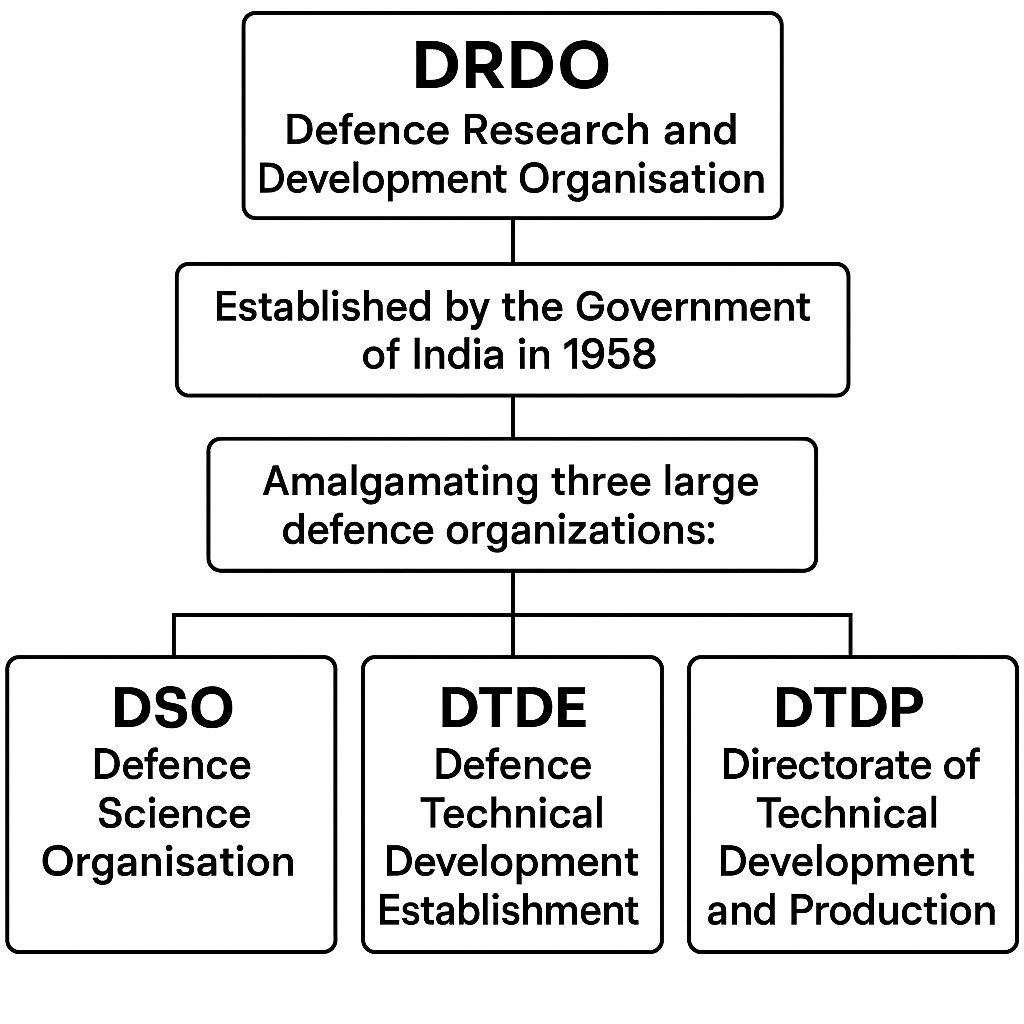The DRDO stands for Defence Research and Development Organisation. The Government of India created DRDO in 1958 under the Ministry of Defence (Raksha Mantralaya).
- DRDO functions under the administrative control of the Ministry of Defence, Government of India.
- It is striving to develop a class science and technology base for India. In addition, it provides our Defence Services with a decisive edge by providing them with internationally competitive systems and solutions.
- Dr. G. Satheesh Reddy is the current Chairman of DRDO.
Defence is a very important and dynamic topic in the UPSC Syllabus, particularly in GS Paper-3.. As DRDO plays an important role in the country’s defence mechanism, it is very important that all UPSC aspirants pay close attention and study DRDO India thoroughly.
For more information, you can also visit the official DRDO website
What is the History of DRDO?
The full form of DRDO is Defence Research and Development Organization. The government of India established it in 1958 by amalgamating three large defense organizations called:
1. Defence Science Organisation or DSO
2. Defence Technical Development Establishment or DTDE
3. Directorate of Technical Development and Production or DTDP.

1. How did DRDO India Grow?
- The DRDO has expanded its network from 10 laboratories to 52, actively developing defense technologies across a range of disciplines that include:
- Aeronautics
- Armaments
- Electronics
- Combat vehicles
- Engineering systems
- Instrumentation
- Missiles
- Advanced computing and simulation
- Special materials
- Naval systems
- Life sciences
- Training
- Information systems
- Agriculture.
- Currently, more than 5,000 scientists and around 25,000 other scientific, technical, and support personnel actively support the Organisation.
- Several major projects are currently developing missiles, armaments, light combat aircraft, radars, electronic warfare systems, and more. These projects have already achieved substantial accomplishments in several related technologies.
2. What is the Major DRDO Achievement?
The history and achievements of DRDO include various missions and initiatives. The first major DRDO defence project was Project Indigo. The program began in 1960 as a Surface-to-Air Missiles (SAM) project, but the team closed it without achieving significant success.
What is the Mission of DRDO India?
Below are the DRDO significance in Indian defence and its mission in three points:
1. Design, develop as well as lead to production of cutting-edge sensors, weapon systems, and platforms. Moreover, to make required equipment for our Defence Services.
2. Further, to provide the Services with technological solutions to enhance their combat effectiveness. Together with this to promote the welfare of the troops.
3. Additionally, to deliver infrastructure and committed quality manpower, and develop a strong indigenous technology base.
What is the List of DRDO Labs?
Below you can go through the DRDO India laboratories:
| City | Labs | |
| Delhi | Defence Terrain Research Laboratory (DTRL) | Institute of Nuclear Medicine & Allied Sciences (INMAS) |
| Centre for Advanced Semiconductor Technology (ASEMIT) | Institute for Systems Studies & Analyses (ISSA) | |
| Centre for Fire, Explosive and Environment Safety (CFEES) | Laser Science & Technology Centre (LASTEC) | |
| Defence Scientific Information & Documentation Centre (DESIDOC) | Scientific Analysis Group (SAG) | |
| Defence Institute of Physiology & Allied Sciences (DIPAS) | Solid State Physics Laboratory (SSPL) | |
| Defence Institute of Psychological Research (DIPR) | ||
| Hyderabad | Advanced Numerical Research & Analysis Group (ANURAG) | Defence Metallurgical Research Laboratory (DMRL) |
| Defence Electronics Research Laboratory (DLRL) | Defence Research & Development Laboratory (DRDL) | |
| Research Centre Imarat (RCI) | ||
| Chandigarh | Snow & Avalanche Study Estt (SASE) | Terminal Ballistics Research Laboratory (TBRL) |
| Bangalore | Aeronautical Development Establishment (ADE) | Defence Avionics Research Establishment (DARE) |
| Centre For Airborne Systems (CABS) | Defence Bioengineering & Electromedical Laboratory (DEBEL) | |
| Centre for Artificial Intelligence & Robotics (CAIR) | Electronics & Radar Development Establishment (LRDE) | |
| Centre for Military Airworthiness & Certification (CEMILAC) | Microwave Tube Research & Development Centre (MTRDC) | |
| Bangalore Gas Turbine Research Establishment (GTRE) | ||
| Pune | Armament Research & Development Establishment (ARDE) | High Energy Materials Research Laboratory (HEMRL) |
| Defence Institute of Advanced Technology (DIAT) | Research & Development Establishment (ARDE) | |
| Dehradun | Instruments Research & Development Establishment (IRDE) | Defence Electronics Application Laboratory (DEAL) |
| Agra | Aerial Delivery Research and Development Establishment (ADRDE) | |
| Nasik | Advanced Centre for Energetic Materials (ACEM) | |
| Chennai | Combat Vehicles Research & Development Establishment (CVRDE) | |
| Mysore | Defence Food Research Laboratory (DFRL) | |
| Haldwani | Defence Institute of Bio-Energy Research (DIBER) | |
| Leh Ladakh | Defence Institute of High Altitude Research (DIHAR) | |
| Jodhpur | Defence Laboratory (DLJ) | |
| Kanpur | Defence Materials and Stores Research and Development Establishment (DMSRDE) | |
| Gwalior | Defence Research & Development Establishment (DRDE) | |
| Tezpur | Defence Research Laboratory (DRL) | |
| Mussoorie | Institute of Technology Management (ITM) | |
| Ambernath | Naval Materials Research Laboratory (NMRL) | |
| Cochin | Naval Physical Oceanographic Laboratory (NPOL) | |
| Visakhapatnam | Naval Science & Technological Laboratory (NSTL) | |
| Balasore | Proof & Experimental Establishment (PXE) | Integrated Test Range (ITR) |
| Ahmednagar | Vehicle Research & Development Establishment (VRDE) | |
What is the Integrated Guided-Missile Development Programme (IGMDP)?
Dr. APJ Abdul Kalam, a prominent scientist and former President of India, played a key role in developing the Integrated Guided Missile Development Programme (IGMDP). It aimed to enhance India’s self-sufficiency in missile technology. Furthermore, approved by the Indian government on July 26, 1983, the IGMDP brought together the nation’s scientific community, academic institutions, research and development laboratories, industry partners, and the three defence services to create strategic, indigenous missile systems.
The IGMDP, a part of DRDO research and development, was designed to address the diverse requirements of the Indian defence forces. Consequently, it led to the development of five key missile systems:
1. Prithvi: A short-range surface-to-surface ballistic missile.
2. Agni: An intermediate-range surface-to-surface ballistic missile that evolved from an initial technology demonstrator project into a sophisticated ballistic missile with various ranges.
3. Trishul: A short-range low-level surface-to-air missile.
4. Akash: A medium-range surface-to-air missile.
5. Nag: A third-generation anti-tank missile.
Thereupon, After successfully achieving its goal of making India self-reliant in missile technology, the Defence Research and Development Organisation (DRDO) announced the formal completion of the IGMDP on January 8, 2008.
NOTE: Recent advancements were notably marked by the successful test-firing of the Agni-P, a new generation nuclear-capable ballistic missile, from Dr. APJ Abdul Kalam Island, Odisha. This significant test, therefore, underscores India’s evolving missile capabilities and highlights Agni-P as an advanced variant in the Agni class. Moreover, it reinforces India’s self-sufficiency in missile technology, showcasing the nation’s commitment to enhancing its defense capabilities. Consequently, these developments not only strengthen India’s strategic position but also demonstrate the country’s technological progress in the field of defense.
1. Below are some of the Missiles:
| Missile System of India | |
| Missile | Features |
| Agni I | Single-stage, solid fuel, medium-range ballistic Missile (MRBM).Using a solid propulsion booster and a liquid propulsion upper stage.Range of 700-800 km. |
| Agni II | Intermediate-Range Ballistic Missile (IRBM).Range more than 2000 km. |
| Agni III | Two-stage IRBMSupport a wide range of warhead configurations.Strike range of more than 2,500 Km |
| Agni IV | Two-stage missile powered by solid propellant.Can fire from a road mobile launcher.The range is more than 3,500 km.Equipped with an indigenously developed ring laser gyro and composite rocket motor. |
| Agni V | Three-stage solid-fueled, indigenous Inter-Continental Ballistic Missile (ICBM).Capable of carrying 1.5 tonnes of nuclear warheads.The latest and most advanced variant in terms of navigation and guidance, warhead and engine.After induction in the military, India will join an exclusive club of countries like the US, Russia, China, France, and Britain, which have intercontinental ballistic missile capability.Canister launches missile system for operational flexibility.The range is more than 5,000 km. |
| Agni P | Canisterised missile with a range capability between 1,000 and 2,000 km.Many advanced technologies, including composites, propulsion systems, innovative guidance and control mechanisms, and state-of-the-art navigation systems have been introduced.The missile would further strengthen India’s credible deterrence capabilities. |
| Trishul | Short-range, quick reaction, all-weather surface-to-air missile designed to counter a low-level attack.Has necessary electronic countermeasures against all known aircraft jammers. |
| Akash | Medium-range, surface-to-air missile with multi-target engagement capability.Multiple warheads capable.High-energy solid propellant and ram-rocket propulsion system. |
| Nag | Third generation ‘fire-and-forget’ anti-tank missile with a range of 4-8km.Developed indigenously as an anti-armour weapon employing sensor fusion technologies for flight guidance.HELINA (Helicopter Launched NAG) is the air-to-surface version of the NAG integrated into Dhruv Helicopters. |
2. Below are some of the Missiles:
| Missile System of India | |
| Missile | Features |
| Prithvi | First indigenously built ballistic missile under IGMDP.Surface-to-surface battlefield missile.Demonstrates higher lethal effects and high-level capability with field-interchangeable warheads.Range from 150 km to 300 km. |
| BrahMos | Supersonic cruise missile.It is being developed with Russia as a private joint venture.Multi-platform cruise can strike from various types of platforms.Among the world’s fastest supersonic cruise missiles with speeds ranging between Mach 2.5 and 2.8.A ‘fire and forget’ weapon, i.e. requiring no further guidance from the control centre once the target has been assigned. |
| Nirbhay | Subsonic missile, supplement to the BrahMos.Capable of being launched from multiple platforms on land, sea and air.A terrain-hugging, stealth missile capable of delivering 24 different types of warheads depending on mission requirements.It can reach up to 1,000 km. |
| Sagarika | Submarine-Launched Ballistic Missile (SLBM)Being integrated with India’s nuclear-powered Arihant-class submarine.Range – 700 km. |
| Shaurya | A variant of the K-15 Sagarika.Submarine- nuclear-capable missile.Aims to enhance India’s second-strike capability. |
| Dhanush | Sea-based, short-range, liquid propellant ballistic missile.Naval version of Prithvi II.Maximum range 350 km. |
| Astra | Beyond-visual-range air-to-air missile using a solid-propellant.In terms of size and weight, it is one of the smallest weapons developed by the DRDO.An active radar seeker to find targets.Electronic counter-measure capabilities.Designed to intercept and destroy enemy aircraft at supersonic speeds in the head-on mode at a range of 80 km. |
| Prahaar | India’s latest surface-to-surface missile has a range of 150 km.The primary objective is to bridge the gap between the unguided Pinaka multi-barrel rocket launcher and the guided Prithvi missile variants.Have high manoeuvrability, acceleration and accuracy. |
What are the Other Initiatives Taken by DRDO?
1. Mobile Autonomous Robot System
MARS is a smart, robust robot to handle land mines and Inert Explosive Devices (IEDs), which helps the Indian Armed Forces to disarm them from far distances despite hostile surroundings.
Coupled with some add-ons, this system can even be used to dig the ground for the object and defuse the Improvised Explosive Device by various methods.
2. Highest Terrestrial Centre in Ladakh
DRDO’s centre in Ladakh is at 17,600 feet above sea level at Changla near Pangong Lake. Certainly, it is intended to serve as a natural cold storage unit for the preservation of natural and medicinal plants.
3. Other Recent Developments by DRDO
- Extreme Cold Weather Clothing System (ECWCS)
- Pralay
- Controlled Aerial Delivery System
- Pinaka Extended Range (Pinaka-ER) Multiple Launch Rocket System (MLRS)
- Supersonic Missile Assisted Torpedo System (SMART)
- Advanced Chaff Technology
- Akash-NG & MPATGM
What are the Challenges Faced by DRDO India?
There are certain problems that the DRDO has experienced in recent. Such as :
1. Budget Isuues
- With attention to the low budget, the SCOD (Standing Committee on Defence) raised its concern regarding the ongoing DRDO projects.
- When the NDA government came into power and increased the problem was in the past.
- By all means, in 2018, military expenses had reached a higher point.
2. ISRO vs DRDO
- Action has been taken by ISRO at times when it has been proven that missions and projects such as the Mars mission were accomplished for less than the cost of some Hollywood films.
- In contrast, bureaucratic management of the DRDO and the inability of the Ministry of Defence to keep pace with changes presented by time have created a gap in some specialised knowledge of defence and strategic affairs.
- As a result, ISRO has seen greater support from the government than DRDO.
3. Lack of Man-Power
- The DRDO also does not have the right and enough man-power in critical areas, and it is not synergised with the armed forces.
- Most of the imports of defence equipment also place a drain on the economy.
- They spend more time improving past technologies instead of striving for innovative ideas, and developing new, leading-edge technologies.
Conclusion
In conclusion, the Defence Research and Development Organisation (DRDO) is India’s leading defence R&D agency and plays an important role in the security and technological self-reliance of the country. Further, DRDO‘s developments in military technology are essential for equipping the Indian Armed Forces and allowing India to emerge as a substantial player in global defence.
Frequently Asked Questions
A: Explicitly, DRDO focuses on developing advanced weapon systems and equipment for the Indian Defence Services, enhancing combat effectiveness, and promoting troop welfare. In addition, it aims to build an indigenous technological base.
A: In particular, candidates must be Indian citizens under 28 (31 for OBC, 33 for SC/ST) with a first-class degree in Engineering or Technology.
A: The Defence Research and Development Organisation is headquartered in New Delhi. Furthermore, it has its 50+ labs all across the country.












